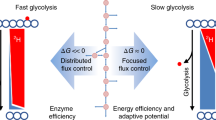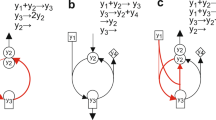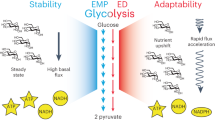Abstract
In metabolism, available free energy is limited and must be divided across pathway steps to maintain a negative ΔG throughout. For each reaction, ΔG is log proportional both to a concentration ratio (reaction quotient to equilibrium constant) and to a flux ratio (backward to forward flux). Here we use isotope labeling to measure absolute metabolite concentrations and fluxes in Escherichia coli, yeast and a mammalian cell line. We then integrate this information to obtain a unified set of concentrations and ΔG for each organism. In glycolysis, we find that free energy is partitioned so as to mitigate unproductive backward fluxes associated with ΔG near zero. Across metabolism, we observe that absolute metabolite concentrations and ΔG are substantially conserved and that most substrate (but not inhibitor) concentrations exceed the associated enzyme binding site dissociation constant (Km or Ki). The observed conservation of metabolite concentrations is consistent with an evolutionary drive to utilize enzymes efficiently given thermodynamic and osmotic constraints.
This is a preview of subscription content, access via your institution
Access options
Subscribe to this journal
Receive 12 print issues and online access
$259.00 per year
only $21.58 per issue
Buy this article
- Purchase on Springer Link
- Instant access to full article PDF
Prices may be subject to local taxes which are calculated during checkout






Similar content being viewed by others
References
Bennett, B.D. et al. Absolute metabolite concentrations and implied enzyme active site occupancy in Escherichia coli. Nat. Chem. Biol. 5, 593–599 (2009).
Henry, C.S., Broadbelt, L.J. & Hatzimanikatis, V. Thermodynamics-based metabolic flux analysis. Biophys. J. 92, 1792–1805 (2007).
Joshi, A. & Palsson, B.O. Metabolic dynamics in the human red cell. Part III—metabolic reaction rates. J. Theor. Biol. 142, 41–68 (1990).
Chassagnole, C., Noisommit-Rizzi, N., Schmid, J.W., Mauch, K. & Reuss, M. Dynamic modeling of the central carbon metabolism of Escherichia coli. Biotechnol. Bioeng. 79, 53–73 (2002).
van Eunen, K. et al. Measuring enzyme activities under standardized in vivo-like conditions for systems biology. FEBS J. 277, 749–760 (2010).
Xu, Y.-F., Amador-Noguez, D., Reaves, M.L., Feng, X.-J. & Rabinowitz, J.D. Ultrasensitive regulation of anapleurosis via allosteric activation of PEP carboxylase. Nat. Chem. Biol. 8, 562–568 (2012).
Cohen, P. Protein kinases—the major drug targets of the twenty-first century? Nat. Rev. Drug Discov. 1, 309–315 (2002).
Nielsen, J. Metabolic engineering. Appl. Microbiol. Biotechnol. 55, 263–283 (2001).
Lu, W. et al. Metabolomic analysis via reversed-phase ion-pairing liquid chromatography coupled to a stand alone orbitrap mass spectrometer. Anal. Chem. 82, 3212–3221 (2010).
Büscher, J.M., Czernik, D., Ewald, J.C., Sauer, U. & Zamboni, N. Cross-platform comparison of methods for quantitative metabolomics of primary metabolism. Anal. Chem. 81, 3212–3221 (2004).
Mashego, M.R. et al. MIRACLE: mass isotopomer ratio analysis of U-13C-labeled extracts. A new method for accurate quantification of changes in concentrations of intracellular metabolites. Biotechnol. Bioeng. 85, 620–628 (2004).
Bennett, B.D., Yuan, J., Kimball, E.H. & Rabinowitz, J.D. Absolute quantitation of intracellular metabolite concentrations by an isotope ratio-based approach. Nat. Protoc. 3, 1299–1311 (2008).
Beard, D.A., Babson, E., Curtis, E. & Qian, H. Thermodynamic constraints for biochemical networks. J. Theor. Biol. 228, 327–333 (2004).
Schellenberger, J., Lewis, N.E. & Palsson, B.Ø. Elimination of thermodynamically infeasible loops in steady-state metabolic models. Biophys. J. 100, 544–553 (2011).
Feist, A.M. et al. A genome-scale metabolic reconstruction for Escherichia coli K-12 MG1655 that accounts for 1260 ORFs and thermodynamic information. Mol. Syst. Biol. 3, 121 (2007).
Flamholz, A., Noor, E., Bar-Even, A., Liebermeister, W. & Milo, R. Glycolytic strategy as a tradeoff between energy yield and protein cost. Proc. Natl. Acad. Sci. USA 110, 10039–10044 (2013).
Kümmel, A., Panke, S. & Heinemann, M. Putative regulatory sites unraveled by network-embedded thermodynamic analysis of metabolome data. Mol. Syst. Biol. 2, 0034 (2006).
Tran, L.M., Rizk, M.L. & Liao, J.C. Ensemble modeling of metabolic networks. Biophys. J. 95, 5606–5617 (2008).
Beard, D.A. & Qian, H. Relationship between thermodynamic driving force and one-way fluxes in reversible processes. PLoS One 2, e144 (2007).
Wiechert, W. The thermodynamic meaning of metabolic exchange fluxes. Biophys. J. 93, 2255–2264 (2007).
Degenhardt, K. & White, E. A mouse model system to genetically dissect the molecular mechanisms regulating tumorigenesis. Clin. Cancer Res. 12, 5298–5304 (2006).
Xu, Y.F., Lu, W. & Rabinowitz, J.D. Avoiding misannotation of in-source fragmentation products as cellular metabolites in liquid chromatography-mass spectrometry–based metabolomics. Anal. Chem. 87, 2273–2281 (2015).
Noor, E., Haraldsdóttir, H.S., Milo, R. & Fleming, R.M.T. Consistent estimation of Gibbs energy using component contributions. PLoS Comput. Biol. 9, e1003098 (2013).
Katz, J., Wals, P. & Lee, W.N. Isotopomer studies of gluconeogenesis and the Krebs cycle with 13C-labeled lactate. J. Biol. Chem. 268, 25509–25521 (1993).
Raamsdonk, L.M. et al. A functional genomics strategy that uses metabolome data to reveal the phenotype of silent mutations. Nat. Biotechnol. 19, 45–50 (2001).
Schomburg, I. et al. BRENDA in 2013: integrated reactions, kinetic data, enzyme function data, improved disease classification: new options and contents in BRENDA. Nucleic Acids Res. 41, D764–D772 (2013).
Minakami, S. & Yoshikawa, H. Thermodynamic considerations on erythrocyte glycolysis. Biochem. Biophys. Res. Commun. 18, 345–349 (1965).
Vojinović, V. & von Stockar, U. Influence of uncertainties in pH, pMg, activity coefficients, metabolite concentrations, and other factors on the analysis of the thermodynamic feasibility of metabolic pathways. Biotechnol. Bioeng. 103, 780–795 (2009).
Henry, C.S., Jankowski, M.D., Broadbelt, L.J. & Hatzimanikatis, V. Genome-scale thermodynamic analysis of Escherichia coli metabolism. Biophys. J. 90, 1453–1461 (2006).
Hoppe, A., Hoffmann, S. & Holzhütter, H.G. Including metabolite concentrations into flux balance analysis: thermodynamic realizability as a constraint on flux distributions in metabolic networks. BMC Syst. Biol. 1, 23 (2007).
Nöh, K. et al. Metabolic flux analysis at ultra short time scale: isotopically non-stationary 13C labeling experiments. J. Biotechnol. 129, 249–267 (2007).
Yuan, J., Fowler, W.U., Kimball, E., Lu, W. & Rabinowitz, J.D. Kinetic flux profiling of nitrogen assimilation in Escherichia coli. Nat. Chem. Biol. 2, 529–530 (2006).
Berg, J.M., Tymoczko, J.L. & Stryer, L. Biochemistry (W.H. Freeman, New York, 2012).
Liebermeister, W. et al. Visual account of protein investment in cellular functions. Proc. Natl. Acad. Sci. USA 111, 8488–8493 (2014).
Valgepea, K., Adamberg, K., Seiman, A. & Vilu, R. Escherichia coli achieves faster growth by increasing catalytic and translation rates of proteins. Mol. Biosyst. 9, 2344–2358 (2013).
de Godoy, L.M. et al. Comprehensive mass-spectrometry–based proteome quantification of haploid versus diploid yeast. Nature 455, 1251–1254 (2008).
Geiger, T., Wehner, A., Schaab, C., Cox, J. & Mann, M. Comparative proteomic analysis of eleven common cell lines reveals ubiquitous but varying expression of most proteins. Mol. Cell. Proteomics 11, 014050 (2012).
Dekel, E. & Alon, U. Optimality and evolutionary tuning of the expression level of a protein. Nature 436, 588–592 (2005).
Beg, Q.K. et al. Intracellular crowding defines the mode and sequence of substrate uptake by Escherichia coli and constrains its metabolic activity. Proc. Natl. Acad. Sci. USA 104, 12663–12668 (2007).
Ralser, M. et al. Dynamic rerouting of the carbohydrate flux is key to counteracting oxidative stress. J. Biol. 6, 10 (2007).
Fell, D. Understanding the Control of Metabolism (Portland Press, 1997).
Heinrich, R. & Schuster, S. The Regulation of Cellular Systems (Chapman & Hall, New York, 1996).
Cornish-Bowden, A. Fundamentals of Enzyme Kinetics (Portland Press, 1995).
Schuster, S. & Heinrich, R. Time hierarchy in enzymatic reaction chains resulting from optimality principles. J. Theor. Biol. 129, 189–209 (1987).
Gutnick, D., Calvo, J.M., Klopotow, T. & Ames, B.N. Compounds which serve as sole source of carbon or nitrogen for Salmonella typhimurium Lt-2. J. Bacteriol 100, 215 (1969).
Rabinowitz, J.D. & Kimball, E. Acidic acetonitrile for cellular metabolome extraction from Escherichia coli. Anal. Chem. 79, 6167–6173 (2007).
Bajad, S.U. et al. Separation and quantitation of water soluble cellular metabolites by hydrophilic interaction chromatography-tandem mass spectrometry. J. Chromatogr. A 1125, 76–88 (2006).
Clasquin, M.F., Melamud, E. & Rabinowitz, J.D. LC/MS data processing with MAVEN: a metabolomic analysis and visualization engine. Curr. Protoc. Bioinformatics 37, 14.11.1–14.1.23 (2012).
Sundararaj, S. et al. The CyberCell Database (CCDB): a comprehensive, self-updating, relational database to coordinate and facilitate in silico modeling of Escherichia coli. Nucleic Acids Res. 32, D293–D295 (2004).
Fan, J. et al. Glutamine-driven oxidative phosphorylation is a major ATP source in transformed mammalian cells in both normoxia and hypoxia. Mol. Syst. Biol. 9, 712 (2013).
Schellenberger, J., Park, J.O., Conrad, T.M. & Palsson, B.Ø. BiGG: a biochemical genetic and genomic knowledgebase of large scale metabolic reconstructions. BMC Bioinformatics 11, 213 (2010).
Kanehisa, M. et al. Data, information, knowledge and principle: back to metabolism in KEGG. Nucleic Acids Res. 42, D199–D205 (2014).
Weitzel, M. et al. 13CFLUX2--high-performance software suite for 13C-metabolic flux analysis. Bioinformatics 29, 143–145 (2013).
Wiechert, W., Möllney, M., Isermann, N., Wurzel, M. & de Graaf, A.A. Bidirectional reaction steps in metabolic networks: III. Explicit solution and analysis of isotopomer labeling systems. Biotechnol. Bioeng. 66, 69–85 (1999).
Antoniewicz, M.R., Kelleher, J.K. & Stephanopoulos, G. Determination of confidence intervals of metabolic fluxes estimated from stable isotope measurements. Metab. Eng. 8, 324–337 (2006).
Fleming, R.M.T., Thiele, I. & Nasheuer, H.P. Quantitative assignment of reaction directionality in constraint-based models of metabolism: application to Escherichia coli. Biophys. Chem. 145, 47–56 (2009).
Haraldsdóttir, H.S., Thiele, I. & Fleming, R.M.T. Quantitative assignment of reaction directionality in a multicompartmental human metabolic reconstruction. Biophys. J. 102, 1703–1711 (2012).
Rosenberg, H., Russell, L.M., Jacomb, P.A. & Chegwidden, K. Phosphate exchange in the pit transport system in Escherichia coli. J. Bacteriol. 149, 123–130 (1982).
Traut, T.W. Physiological concentrations of purines and pyrimidines. Mol. Cell. Biochem. 140, 1–22 (1994).
Leonardi, R., Zhang, Y.M., Rock, C.O. & Jackowski, S. Coenzyme A: back in action. Prog. Lipid Res. 44, 125–153 (2005).
Acknowledgements
The authors would like to thank the Gitai, Silhavy, Brynildsen and White labs for strains and cell lines and H. Haraldsdóttir, E. Noor and R. Fleming for their help with Component Contribution method. J. Fan was supported by a Howard Hughes Medical Institute international student research fellowship. Funding was provided by US Department of Energy grant DE-SC0012461, and US National Institutes of Health R01grant 1R01CA163591 and DRC grant 2P30DK019525-37..
Author information
Authors and Affiliations
Contributions
J.O.P., S.A.R., Y.-F.X., T.S. and J.D.R. designed the study. J.O.P., S.A.R., Y.-F.X., D.A.-N. and J.F. carried out the experiments. J.O.P. and S.A.R. developed the computational tools. J.O.P., S.A.R. and J.D.R. wrote the paper.
Corresponding author
Ethics declarations
Competing interests
The authors declare no competing financial interests.
Supplementary information
Supplementary Text and Figures
Supplementary Results, Supplementary Tables 1–8 and Supplementary Figures 1–4. (PDF 1710 kb)
Supplementary Data Set 1
Steady-state metabolite labeling from various 13C tracers. (XLSX 90 kb)
Supplementary Data Set 2
Comparison of absolute concentrations to enzyme binding site affinities for substrates. (XLSX 120 kb)
Supplementary Data Set 3
Comparison of absolute concentrations to enzyme binding site affinities for inhibitors. (XLSX 34 kb)
Rights and permissions
About this article
Cite this article
Park, J., Rubin, S., Xu, YF. et al. Metabolite concentrations, fluxes and free energies imply efficient enzyme usage. Nat Chem Biol 12, 482–489 (2016). https://doi.org/10.1038/nchembio.2077
Received:
Accepted:
Published:
Issue Date:
DOI: https://doi.org/10.1038/nchembio.2077
This article is cited by
-
Rational strain design with minimal phenotype perturbation
Nature Communications (2024)
-
Complex regulation in a Comamonas platform for diverse aromatic carbon metabolism
Nature Chemical Biology (2023)
-
A parallel glycolysis provides a selective advantage through rapid growth acceleration
Nature Chemical Biology (2023)
-
Local flux coordination and global gene expression regulation in metabolic modeling
Nature Communications (2023)
-
Optimal enzyme utilization suggests that concentrations and thermodynamics determine binding mechanisms and enzyme saturations
Nature Communications (2023)



